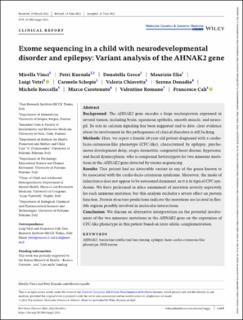Exome sequencing in a child with neurodevelopmental disorder and epilepsy: Variant analysis of the AHNAK2 gene
| dc.contributor.author | Vinci, Mirella | |
| dc.contributor.author | Kursula, Petri | |
| dc.contributor.author | Greco, Donatella | |
| dc.contributor.author | Elia, Maurizio | |
| dc.contributor.author | Vetri, Luigi | |
| dc.contributor.author | Schepis, Carmelo | |
| dc.contributor.author | Chiavetta, Valeria | |
| dc.contributor.author | Donadio, Serena | |
| dc.contributor.author | Roccella, Michele | |
| dc.contributor.author | Carotenuto, Marco | |
| dc.contributor.author | Romano, Valentino | |
| dc.contributor.author | Calì, Francesco | |
| dc.date.accessioned | 2023-03-23T12:31:49Z | |
| dc.date.available | 2023-03-23T12:31:49Z | |
| dc.date.created | 2022-09-29T09:04:15Z | |
| dc.date.issued | 2022 | |
| dc.identifier.issn | 2324-9269 | |
| dc.identifier.uri | https://hdl.handle.net/11250/3060122 | |
| dc.description.abstract | Background The AHNAK2 gene encodes a large nucleoprotein expressed in several tissues, including brain, squamous epithelia, smooth muscle, and neuropil. Its role in calcium signaling has been suggested and to date, clear evidence about its involvement in the pathogenesis of clinical disorders is still lacking. Methods Here, we report a female 24-year-old patient diagnosed with a cardio-facio-cutaneous-like phenotype (CFC-like), characterized by epilepsy, psychomotor development delay, atopic dermatitis, congenital heart disease, hypotonia, and facial dysmorphism, who is compound heterozygote for two missense mutations in the AHNAK2 gene detected by exome sequencing. Results This patient had no detectable variant in any of the genes known to be associated with the cardio-facio-cutaneous syndrome. Moreover, the mode of inheritance does not appear to be autosomal dominant, as it is in typical CFC syndrome. We have performed in silico assessment of mutation severity separately for each missense mutation, but this analysis excludes a severe effect on protein function. Protein structure predictions indicate the mutations are located in flexible regions possibly involved in molecular interactions. Conclusion We discuss an alternative interpretation on the potential involvement of the two missense mutations in the AHNAK2 gene on the expression of CFC-like phenotype in this patient based on inter-allelic complementation. | en_US |
| dc.language.iso | eng | en_US |
| dc.publisher | Wiley | en_US |
| dc.rights | Attribution-NonCommercial-NoDerivatives 4.0 Internasjonal | * |
| dc.rights.uri | http://creativecommons.org/licenses/by-nc-nd/4.0/deed.no | * |
| dc.title | Exome sequencing in a child with neurodevelopmental disorder and epilepsy: Variant analysis of the AHNAK2 gene | en_US |
| dc.type | Journal article | en_US |
| dc.type | Peer reviewed | en_US |
| dc.description.version | publishedVersion | en_US |
| dc.rights.holder | Copyright 2022 The Author(s) | en_US |
| dc.source.articlenumber | e2012 | en_US |
| cristin.ispublished | true | |
| cristin.fulltext | original | |
| cristin.qualitycode | 1 | |
| dc.identifier.doi | 10.1002/mgg3.2012 | |
| dc.identifier.cristin | 2056665 | |
| dc.source.journal | Molecular Genetics & Genomic Medicine | en_US |
| dc.identifier.citation | Molecular Genetics & Genomic Medicine. 2022, 10 (9), e2012. | en_US |
| dc.source.volume | 10 | en_US |
| dc.source.issue | 9 | en_US |
Tilhørende fil(er)
Denne innførselen finnes i følgende samling(er)
-
Department of Biomedicine [709]
-
Registrations from Cristin [9688]

